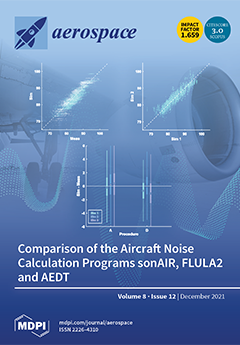Open AccessArticle
Multi-Mode Interferometry: Application to TiO2–SiO2 Sol-Gel Waveguide-Based Sensing in the Aerospace Domain
by
Maxime Royon, Thomas Blanchet, Muhammad Adnan, Damien Jamon, François Royer, Francis Vocanson, Emmanuel Marin, Adriana Morana, Aziz Boukenter, Youcef Ouerdane, Yves Jourlin, Rolf Evenblij, Thijs Van Leest, Aditya Wankhade, Marie-Anne De Smet, Kathryn Atherton and Sylvain Girard
Cited by 1 | Viewed by 2301
Abstract
The optimization of a 2D optical sensor based on TiO
2–SiO
2 sol-gel waveguides for damage detection in the aerospace domain was performed in the framework of the ADD-ON European project. The sensor is based on the transportation of visible light along
[...] Read more.
The optimization of a 2D optical sensor based on TiO
2–SiO
2 sol-gel waveguides for damage detection in the aerospace domain was performed in the framework of the ADD-ON European project. The sensor is based on the transportation of visible light along numerous waveguides, and damage is detected and localized through the monitoring of the output light from the waveguide grid. In this work, we have developed an architecture, inspired by a multi-mode interferometer (MMI), allowing us to efficiently multiply the number of waveguides that can be probed by a single optical source. For this, the beam propagation method (BPM) was used to model a rectangular MMI coupler (40 × 5624 µm
2) operating in the visible region (600 nm), ensuring the propagation of light into three waveguides. The conceived device was then manufactured by UV photolithography (direct laser writing technique). The simulations and experimental results show that light transport into this architecture allows for the successful simultaneous probing of three waveguides. By complexifying the device structure, successful MMI couplers were easily manufactured, allowing us to probe 9, 15, or 45 TiO
2–SiO
2 waveguides with a unique light source. Finally, a further investigation regarding 24 consecutive thermal cycles from −40 °C to 60 °C, representative of the temperature changes during aircraft cruising, was performed. This study reveals that TiO
2–SiO
2 sol-gel waveguides are not mechanically damaged by temperature changes, while the light guidance remains unaffected, confirming that this sensor is very promising for aerospace applications. Since a single source can monitor several guides, the production of more compact, low-cost, and less intrusive sensors can be achieved by fulfilling structural health monitoring requirements.
Full article
►▼
Show Figures





